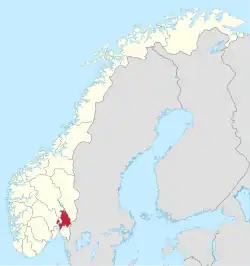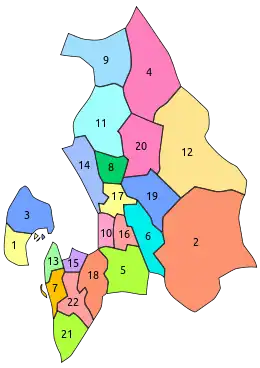Akershus
Akershus (Norwegian pronunciation: [ɑkəʂˈhʉːs] ⓘ)[1] is a traditional region, former and future county, and current electoral district in Norway, with Oslo as its main city and traditional capital. It is named after the Akershus Fortress in Oslo. From the middle ages to 1919, Akershus was a fief and main county that included most of Eastern Norway, and from the 17th century until 2020, Akershus also had a more narrow meaning as a (sub) county that included most of the Greater Oslo Region. After 2020 the former county of Akershus was merged into Viken along with the former counties of Østfold and Buskerud. In 2022 the Storting voted to dissolve Viken and reestablish Akershus county.[2]
Akershus | |
|---|---|
| Akershus fylke | |
 Akershus Fortress, in modern Oslo, was the namesake and center of the region of Akershus since the middle ages, and was located within Akershus main county until 1919. | |
 Akershus within Norway | |
| Country | Norway |
| County | Akershus |
| Region | Østlandet |
| County ID | NO-02 |
| Administrative centre | Oslo |
| Government | |
| • Governor | Valgerd Svarstad Haugland, KrF (2011–2018) |
| • County mayor | Anette Solli, Høyre (2013–2019) |
| Area | |
| • Total | 4,918 km2 (1,899 sq mi) |
| • Land | 4,579 km2 (1,768 sq mi) |
| • Rank | 16th in Norway, 1.50% of Norway's land area |
| Population (30 September 2019) | |
| • Total | 630,752 |
| • Rank | 2 (10.67% of country) |
| • Density | 134/km2 (350/sq mi) |
| • Change (10 years) | 13.7 % |
| Time zone | UTC+01 (CET) |
| • Summer (DST) | UTC+02 (CEST) |
| Official language form | Bokmål |
| Website | www |
Originally Akershus was one of four main fiefs in Norway and included almost all of Eastern Norway. The original Akershus became a main county (Stiftamt or Stift) in 1662 and was sometimes also known as Christiania Stift. It included several subcounties (Amt or Underamt); in 1682 its most central areas, consisting of modern Oslo and Akershus, became the subcounty of Akershus within the larger main county of the same name. In 1842 the capital city of Christiania, which at the time consisted of a tiny part of modern Oslo, became a separate subcounty within Akershus main county. The main county of Akershus was disestablished in 1919, and the subcounty continued as Akershus county (fylke). During its history Akershus (sub) county ceded territory to Oslo several times; Akershus' most central and important municipality, Aker, was transferred to Oslo in 1948.
The remaining county of Akershus after 1948 borders Hedmark, Oppland, Buskerud, Oslo, and Østfold; it also has a short border with Sweden (Värmland). Akershus, with a little over 614,000 inhabitants, is the second most populated county by population after Oslo. The county administration is in central Oslo, which is not part of the modern county per se.
| Year | Pop. | ±% |
|---|---|---|
| 1951 | 183,116 | — |
| 1961 | 234,323 | +28.0% |
| 1971 | 324,390 | +38.4% |
| 1981 | 369,193 | +13.8% |
| 1991 | 418,114 | +13.3% |
| 2001 | 471,988 | +12.9% |
| 2011 | 545,653 | +15.6% |
| 2018 | 614,026 | +12.5% |
| Source: Statistics Norway.[3] | ||
Geography
As a geographical term the meaning of Akershus has changed over time. Akershus originally primarily referred to Akershus main county, which included most of Eastern Norway, with the exception of Upper Telemark and Båhuslen (now mainly part of Sweden). The modern Akershus county is a direct continuation of the subcounty of Akershus, created in 1682, and included all of modern Oslo and Akershus. In 1842 the capital city of Christiania, which at the time consisted of a tiny part of modern Oslo, became a separate subcounty within Akershus main county. Akershus main county ceased to exist in 1919, after which Akershus in everyday usage became synonymous with the modern county that excluded Christiania. Akershus' most central and important municipality, Aker, was transferred to and merged with Oslo in 1948.
After 1948, the remaining Akershus county is conventionally divided into Asker and Bærum to the west of Oslo, Follo and Romerike.
Embracing numerous suburbs and urban areas of Oslo, notably Bærum and historically Aker, Akershus is one of the most densely populated areas in the country. The main national railway lines into Oslo run through Akershus with many junctions and stations such as Asker, Sandvika, Ski, and Lillestrøm. Akershus includes some of the lake Mjøsa and some of the river Glomma.
The county also includes the historical place Eidsvoll, 48 km north of Oslo, in which the national assembly ratified the Norwegian constitution in 1814. South of Eidsvoll is the international airport, Oslo Airport at Gardermoen. Oslo's previous international airport, Fornebu, is also located in Akershus. The estate of the crown prince is located in Asker (the royal palace is in Oslo).
Infrastructure
The county has two major hospitals, Akershus University Hospital and Sykehuset Asker og Bærum.
The main road from continental Europe, E6, enters Akershus in the south, and runs through eastern Oslo, further to Gardermoen, and into Hedmark County on the eastern shores of lake Mjøsa.
E18 enters Akershus in the south-east, merges for a short stretch with E6 at Vinterbro in Ås, before running under central Oslo. E18 then turns south-west through Bærum and Asker before entering Buskerud County north of Drammen.
E16 runs from the intersection with E18 in Sandvika into Buskerud County west of Sollihøgda.
All main railways out of Oslo run through Akershus:
- Southwest: the Drammen Line
- Southeast: the Østfold Line as two separate railways
- North: the Gjøvik Line
- Northeast: the Trunk Line, Gardermoen Line, and Dovre Line
- East: the Kongsvinger Line
History
Akershus became a fief in the 16th century, and then also included the current counties of Hedmark, Oppland, Buskerud, and Oslo, as well as the municipalities of Askim, Eidsberg, and Trøgstad in the county of Østfold. In 1662, Akershus became an Amt, and in 1685, Buskerud was separated from Akershus and became an Amt of its own. In 1768, Hedmark and Oppland were also separated from Akershus to become Oplandenes Amt (and Askim, Eidsberg, and Trøgstad were transferred to Østfold). In 1842, the city of Christiania (Oslo) was made a separate Amt, as well. In 1919, the term Amt was changed to Fylke. In 1948, Aker, the greatest and the most populous municipality of Akershus, was transferred to the county of Oslo.
Name
The county is named after Akershus Fortress. The fortress was built in 1299, and the meaning of the name is "the (fortified) house of (the district) Aker". The name is somewhat misleading now, since the fortress is now outside Akershus (it is in Oslo County since 1842). In fact, the administration of Akershus sits outside the county, as well, in the centre of Oslo.
Coat-of-arms
The coat-of-arms is from modern times (1987). It shows a gable from Akershus Fortress.
Municipalities

Akershus has a total of 22 municipalities:
| Number of minorities (1st and 2nd gen.) in Akershus by country of origin in 2017[6] | |
| Nationality | Population (2017) |
|---|---|
| 15,685 | |
| 7,351 | |
| 7,050 | |
| 5,090 | |
| 4,472 | |
| 4,252 | |
| 4,127 | |
| 3,643 | |
| 3,461 | |
| 3,290 | |
| 3,265 | |
| 3,053 | |
| 2,939 | |
| 2,839 | |
| 2,765 | |
| 2,381 | |
| 2,310 | |
| 2,233 | |
| 2,066 | |
| 1,812 | |
| 1,786 | |
| 1,725 | |
| 1,547 | |
| 1,537 | |
| 1,320 | |
Districts
Cities
Parishes
- Asker
- Aurskog
- Bjørke
- Blaker
- Bærum
- Drøbak
- Eidsvoll
- Enebakk
- Feiring
- Fenstad
- Fet
- Frogn
- Frogner
- Garder
- Gjerdrum
- Hakadal
- Hemnes
- Heni
- Holter
- Hovin
- Hurdal
- Hvitsten
- Høland
- Høvik
- Kroer
- Kråkstad
- Langset
- Lillestrøm
- Løken, see Høland
- Lørenskog
- Maria kirke
- Nannestad
- Nes
- Nesodden
- Nittedal
- Nordby
- Oppegård
- Rælingen
- Setskog (Sitskogen)
- Skedsmo
- Ski
- Stensgård
- Søndre Høland
- Sørum
- Såner
- Udenes
- Ullensaker
- Vestby
- Vestre Bærum
- Østre Bærum
- Ås
Villages
- Algarheim
- Alværn
- Ask
- Askkroken
- Aulifeltet
- Aursmoen
- Bekkeberga
- Bekkestua
- Berger
- Billingstad
- Bjerkås
- Bjørkelangen
- Bjørnemyr
- Blaker
- Blakstad
- Blommenholm
- Blylaget
- Blystadlia
- Bodung
- Bomannsvik
- Borgen, Asker
- Borgen, Ullensaker
- Brevik
- Bråtesletta
- Brudalen
- Brårud
- Burås
- Bærums Verk
- Bærumsmarka
- Bøn
- Dal
- Dalsroa
- Danskerud
- Dikemark
- Drengsrud
- Drøbak
- Dønski
- Eidsvoll Verk
- Eiksmarka
- Eltonåsen
- Enebakkneset
- Fagerstrand
- Feiring
- Fenstad
- Finnbråten
- Finstadbru
- Finstadjordet
- Fjellfoten
- Fjellhamar
- Fjellsrud
- Fjellstad
- Fjellstrand
- Fjerdingby
- Flaskebekk
- Flateby
- Fosser
- Frogner
- Gan
- Garder
- Gardermoen
- Grav
- Greverud
- Grinitajet
- Grønlundfjellet
- Grønvoll
- Gullhella
- Gullverket
- Haga
- Hakadal
- Hammerstad
- Hauerseter
- Hanaborg
- Heer
- Hellerud
- Hellvik, Akershus
- Hemnes
- Hogsetfeltet
- Hurdal
- Hurdal Verk
- Hvam
- Hvitsten
- Hølen
- Høvik
- Håkavik
- Ingeborgrud
- Jessheim
- Jong
- Kampå
- Kirkebygda
- Kirkerud
- Kjeller
- Kjenn
- Kjul
- Kjøvangen
- Kjøya
- Kløfta
- Kolbotn
- Konglungen
- Kringler
- Kråkstad
- Kurland
- Langhus
- Langset
- Leirsund
- Lierfoss
- Lindeberg
- Lommedalen
- Lundermoen
- Lysaker
- Løkeberg
- Løken
- Løkenfeltet
- Lørenfallet
- Løstad
- Løvenstad
- Maura
- Minnesund
- Mogreina
- Momoen
- Nerdrum
- Nesbru
- Neskollen
- Nesoddtangen
- Nesset
- Nesøya
- Nordbyhagen
- Nordkisa
- Oksval
- Onsrud
- Oppegård
- Oppåkermoen
- Pepperstad skog
- Rasta
- Rotnes
- Rud
- Rustadbruk
- Rustadmoen
- Rykkinn
- Rælingen
- Røykås
- Råholt
- Rånåsfoss
- Sand
- Sem
- Sessvollmoen
- Seterstøa
- Setskog
- Siggerud
- Sjøstrand
- Skaugum
- Skedsmokorset
- Skiphelle
- Skjetten
- Skotbu
- Skrukkelia
- Skulerud
- Skytta
- Skårer
- Slattum
- Slattumhagen
- Smestad
- Sofiemyr
- Solberg
- Solemskogen
- Son
- Store Brevik
- Strømmen
- Styrigrenda
- Sundbyhagen
- Svarterud
- Svartskog
- Svestad
- Sværsvann
- Sørumsand
- Såner
- Tanum
- Teigebyen
- Togrenda
- Torget, Hurdal
- Torget, Nesodden
- Trandum
- Trollåsen
- Tårnåsen
- Ursvik
- Vardeåsen
- Vestby
- Vettre
- Vevelstad
- Vinterbro
- Visperud
- Voll
- Vollen
- Vormsund
- Vøyenenga
- Ytre Enebakk
- Østerås
- Åkrene
- Åneby
- Årnes
- Ås
- Åsgreina
- Åsgrenda
- Sundet
Former municipalities
Notable residents
People from Akershus
- Kristoffer Ajer (1998-), football player (Celtic FC), national team.
- Harriet Backer (1845-1932), artist, painter educated in Oslo, Berlin, Munich and Paris.
- Jo Benkow (1924-2013), WWII pilot and politician, President of Stortinget 1985-1993.
- John Carew (1979-), former football player (Lørenskog, Vålerenga, Valencia, Lyon, Aston Villa), with 24 goals for Norway.
- Bjørn Dæhlie (1967), cross-country skier and most-winning skier globally, with 8 gold medals from Winter Olympics.
- Kai Eide, diplomat, writer and politician. Special UN envoy to Kosovo in 2005, Head of UN Mission to Afghanistan 2008-2010.
- Åslaug Haga (1959-), politician, member of parliament and government, President of Global Crop Diversity Trust 2013-2020.
- Morten Harket (1959-), musician and singer, vocal of pop group A-ha.
- Trygve Haavelmo (1911-1999), economist and Nobel Prize laureate.
- Anniken Huitfeldt, politician, Chair of Stortinget Committee on Foreign Relations and Defence.
- Carl Otto Løvenskiold (1839-1916), politician, and briefly Prime Minister in Stockholm in 1884.
- Rolf Presthus (1936-1988), politician, former Chairman of Conservative Party and Minister of Finance.
- Jan Tore Sanner (1966-), politician, Minister of Finance in Norway since 2020.
- Reiulf Steen (1933-2014), politician, Chairman of the Norwegian Labour Party 1965-1975
- Johan Herman Wessel (1742-1785), poet and early satiric author.
References
- Berulfsen, Bjarne (1969). Norsk Uttaleordbok (in Norwegian). Oslo: H. Aschehoug & Co (W Nygaard). p. 20.
- "Stortinget vedtok fylkesoppdeling". Aftenposten. Retrieved 27 June 2022.
- "Projected population - Statistics Norway". Archived from the original on 2013-10-23. Retrieved 2018-10-06.
- Statistics Norway - Church of Norway.
- Statistics Norway - Members of religious and life stance communities outside the Church of Norway, by religion/life stance. County. 2006-2010 Archived 2011-11-02 at the Wayback Machine
- "Immigrants and Norwegian-born to immigrant parents, by immigration category, country background and percentages of the population". ssb.no. Archived from the original on 2 July 2015. Retrieved 26 June 2017.
External links
- Akershus county website
 Media related to Akershus at Wikimedia Commons
Media related to Akershus at Wikimedia Commons Akershus travel guide from Wikivoyage
Akershus travel guide from Wikivoyage


